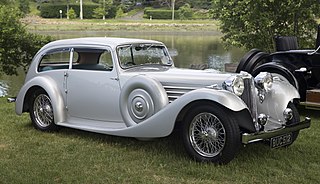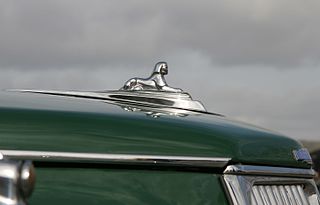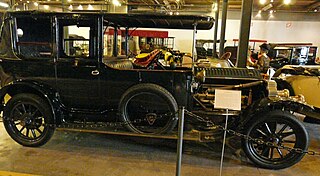
Argyll was a Scottish motor car marque manufactured from 1899 to 1932, and again from 1976 to around 1990.
Armstrong Siddeley was a British engineering group that operated during the first half of the 20th century. It was formed in 1919 and is best known for the production of luxury vehicles and aircraft engines.

The Ford Sidevalve is a side valve from the British arm of the Ford Motor Company, often also referred to as the "English Sidevalve". The engine had its origins in the 1930s Ford Model Y, and was made in two sizes, 933 cc (56.9 cu in) or "8 HP", and 1,172 cc (71.5 cu in) or "10 HP". The early engines did not have a water pump as standard, instead relying on thermosiphon cooling as the Model T engine had. A water pump was added in 1953 for the 100E models when the engine was re-engineered to the point that few specifications are identical between the early and the later series. The Sidevalve engine was used in many smaller Fords as well as farm vehicles, commercial vehicles and a marine version in boats. Production of the engine was stopped in 1962. Windscreen wipers were often driven by the vacuum generated in the inlet manifold.

The Morgan 4/4 is a British motor car which was produced by the Morgan Motor Company from 1936 to 2018. It was Morgan's first car with four wheels, the name indicating that the model has four wheels and four cylinders. Early publicity and advertising material variously referred to the model as "4/4", "4-4", "Four Four", and similar names, but from the outset the factory designation was always "4/4".

The SS 1 is a British two-door sports saloon and tourer built by Swallow Coachbuilding Company in Foleshill, Coventry, England. It was first presented to the public at the 1931 London Motor Show. In slightly modified form, it went on to be manufactured between 1932 and 1936, during which time 148 cars were built.
The Lanchester Motor Company Limited was a British car manufacturer in active trade between 1899 and 1955. Though the Lanchester Motor Company Limited is still registered as an active company and accounts are filed each year, the marque has been dormant since. As of 2014 it is marked as "non-trading".

The Siddeley-Deasy Motor Car Company Limited was a British automobile, aero engine and aircraft company based in Coventry in the early 20th century. It was central to the formation, by merger and buy-out, of the later Armstrong Siddeley Motor and Armstrong Whitworth Aircraft companies.

The Rolls-Royce Silver Ghost name refers both to a car model and one specific car from that series. Originally named the "40/50 h.p." the chassis was first made at Royce's Manchester works, with production moving to Derby in July 1908, and also, between 1921 and 1926, in Springfield, Massachusetts, USA. Chassis no. 60551, registered AX 201, was the car that was originally given the name "Silver Ghost". Other 40/50 hp cars were also given names, but the Silver Ghost title was taken up by the press, and soon all 40/50s were called by the name, a fact not officially recognised by Rolls-Royce until 1925, when the Phantom range was launched.

The Armstrong Siddeley Sapphire is a large automobile which was produced by the British company, Armstrong Siddeley Motors Limited, from 1952 to 1960.
Morris Cowley was a name given to various cars produced by Morris from 1915 to 1958.
The Rover 8 was a small single-cylinder 8 hp 1327 cc car made by the British Rover car company. It was Rover's first production car. It was remarkable for being supported by a backbone chassis rather than a conventional ladder frame. The first model was manufactured from 1904 to 1912. A Daimler-Knight sleeve valve engine option was available on the original model in 1911 and 1912.

The Triumph Dolomite is a car that was produced by Triumph Motor Company from 1934 to 1940. It first appeared in 1934 as a sports car and the name was also used from 1937 on a series of sporting saloons and open cars until 1939 when the company went into receivership. A number were still sold and registered in 1940, though it is uncertain whether the receiver or new owner turned out cars from spare parts, or sold off completed cars. All except the Straight 8 featured a "waterfall" grille styled by Walter Belgrove, versions of the saloons with conventional grilles were sold as Continental models.

The Riley MPH is a small production, two-seat sports car made between 1934 and 1935 by the Riley company of Coventry, England. Very few were made, and examples are now highly sought after.

The Rolls-Royce 15 hp was one of four cars to be produced as a result of an agreement of 23 December 1904 between Charles Rolls and Henry Royce. Badged as a Rolls-Royce, the 15 hp was produced by Royce's company, Royce Ltd., at its factory in Cooke Street, Hulme, Manchester. It was sold exclusively by Rolls' motor dealership, C.S.Rolls & Co., at a price of GBP500. The 15 hp was exhibited at the Paris Salon in December 1904, along with the 10 hp, 20 hp and engine for the 30 hp models, but as the new three-cylinder engine was not ready the chassis was incomplete.
The Rolls-Royce 20 hp was one of four car models to be produced as a result of an agreement of 23 December 1904 between Charles Rolls and Henry Royce. Badged as a Rolls-Royce, the 20 hp was produced during 1905 and 1906 by Royce's company, Royce Ltd. at its factory in Cooke Street, Hulme, Manchester. It was sold exclusively by Rolls' motor dealership, C.S.Rolls & Co., at a price of GBP650. The 20 hp was exhibited at the Paris Salon in December 1904, along with the 10 hp, 15 hp and engine for the 30 hp models.

The Rover 12 was a name given to several medium-sized family cars from the British Rover car company between 1905 and 1948.

The Armstrong Siddeley Lancaster is an automobile which was produced by Armstrong Siddeley Motors Limited from 1945 until 1952. It was the first post-war sports saloon to be made by the company.

The Armstrong Siddeley Hurricane is a two-door, four-seat drophead coupé automobile produced by the British company of Armstrong Siddeley from 1946 until 1953. It was based on the Armstrong Siddeley Lancaster saloon.

The Armstrong Siddeley Typhoon is a two-door, four-seat fixed-head coupé automobile produced by the British company Armstrong Siddeley from 1946 until 1949. It was based on the Armstrong Siddeley Lancaster saloon and continued the company's theme of naming cars after Hawker Siddeley World War II aircraft.

The Vauxhall 27, 30 and 35 h.p. is a large six cylinder car manufactured by Vauxhall from 1910 to 1914. The 27 h.p. was Vauxhall's first six-cylinder car.
















